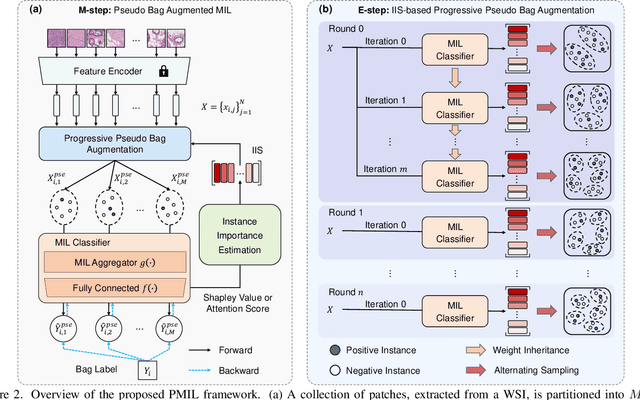Yiqing Liu
FECT: Classification of Breast Cancer Pathological Images Based on Fusion Features
Jan 17, 2025



Abstract:Breast cancer is one of the most common cancers among women globally, with early diagnosis and precise classification being crucial. With the advancement of deep learning and computer vision, the automatic classification of breast tissue pathological images has emerged as a research focus. Existing methods typically rely on singular cell or tissue features and lack design considerations for morphological characteristics of challenging-to-classify categories, resulting in suboptimal classification performance. To address these problems, we proposes a novel breast cancer tissue classification model that Fused features of Edges, Cells, and Tissues (FECT), employing the ResMTUNet and an attention-based aggregator to extract and aggregate these features. Extensive testing on the BRACS dataset demonstrates that our model surpasses current advanced methods in terms of classification accuracy and F1 scores. Moreover, due to its feature fusion that aligns with the diagnostic approach of pathologists, our model exhibits interpretability and holds promise for significant roles in future clinical applications.
Physical encryption and decryption for secure data transmission in optical networks leveraging the temporal Talbot effect and microwave photonics
Jul 12, 2024Abstract:A novel microwave photonic scheme for secure data transmission in optical networks is proposed. The security of the scheme is guaranteed by physical encryption and decryption via the temporal Talbot effect in dispersive mediums. First, the original data is randomized in the digital domain by performing an exclusive OR operation using a random matrix. Subsequently, a time-varying multi-tone electrical signal, which represents the randomized data matrix, is modulated onto an optical carrier. The optical signal after modulation is then phase-modulated by a temporal Talbot array illuminator (TAI) signal, and the optical signal after discrete quadratic phase modulation will lose its original appearance in the frequency domain and be further dispersed in the first dispersive medium. Due to the dispersion that does not match the TAI signal exactly, the waveform after the first dispersive medium is a noise-like signal. Hence, the physical encryption of the original data is successfully achieved. As the optical signal passes a second dispersive medium that makes the total dispersion match the TAI signal, the temporal waveform of the noise-like signal after photodetection is transformed into pulses. "1" and "0" in the randomized data matrix are represented through the presence and absence of pulses, and the physical decryption is achieved. By further processing the recovered data matrix using the random matrix, the original data can be recovered. The physical layer security of the proposed scheme and its fiber transmission capability are demonstrated. 8-Gbit/s data is transmitted, encrypted, and decrypted using two dispersive mediums and an optical fiber of 10 to 200 km, and error-free transmission is achieved. Many factors that affect the encryption, decryption, and transmission performance of the system have been analyzed.
Shapley Values-enabled Progressive Pseudo Bag Augmentation for Whole Slide Image Classification
Dec 09, 2023



Abstract:In computational pathology, whole slide image (WSI) classification presents a formidable challenge due to its gigapixel resolution and limited fine-grained annotations. Multiple instance learning (MIL) offers a weakly supervised solution, yet refining instance-level information from bag-level labels remains complex. While most of the conventional MIL methods use attention scores to estimate instance importance scores (IIS) which contribute to the prediction of the slide labels, these often lead to skewed attention distributions and inaccuracies in identifying crucial instances. To address these issues, we propose a new approach inspired by cooperative game theory: employing Shapley values to assess each instance's contribution, thereby improving IIS estimation. The computation of the Shapley value is then accelerated using attention, meanwhile retaining the enhanced instance identification and prioritization. We further introduce a framework for the progressive assignment of pseudo bags based on estimated IIS, encouraging more balanced attention distributions in MIL models. Our extensive experiments on CAMELYON-16, BRACS, and TCGA-LUNG datasets show our method's superiority over existing state-of-the-art approaches, offering enhanced interpretability and class-wise insights. We will release the code upon acceptance.
 Add to Chrome
Add to Chrome Add to Firefox
Add to Firefox Add to Edge
Add to Edge